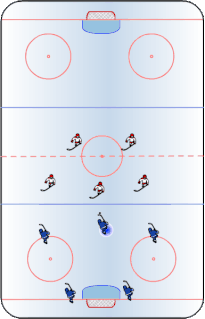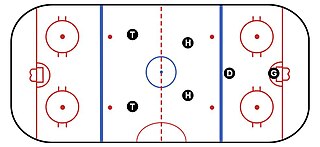Related Research Articles

Ice hockey is a team sport played on ice skates, usually on an ice skating rink with lines and markings specific to the sport. It belongs to a family of sports called hockey. In ice hockey, two opposing teams use ice hockey sticks to control, advance and shoot a closed, vulcanized, rubber disc called a "puck" into the other team's goal. Each goal is worth one point. The team which scores the most goals is declared the winner. In a formal game, each team has six skaters on the ice at a time, barring any penalties, one of whom is the goaltender. Ice hockey is a full contact sport.
Short-handed is a term used in ice hockey and several related sports, including water polo, and refers to having fewer skaters (players) on the ice during play, as a result of a penalty. The player removed from play serves the penalty in the penalty box for a set amount of time proportional to the severity of the infraction. If a goaltender commits a minor infraction, another player who was on the ice at the time of the penalty serves, often but not necessarily the team captain.

The centre in ice hockey is a forward position of a player whose primary zone of play is the middle of the ice, away from the sideboards. Centres have more flexibility in their positioning and therefor often end up covering more ice surface than any other player. Centres are ideally strong, fast skaters who are able to back-check quickly from deep in the opposing zone. Generally, centres are expected to be gifted passers more so than goal scorers, although there are exceptions - typically larger centres who position themselves directly in front of the net in order to score off rebounds. They are also expected to have exceptional "ice vision", intelligence, and creativity. They also generally are the most defensively-oriented forwards on the ice, as they are expected to play the role of the third player in defense, after the defencemen. Centres usually play as part of a line of players that are substituted frequently to keep fresh and keep the game moving.

Winger, in the game of ice hockey, is a forward position of a player whose primary zone of play is along the outer playing areas. They typically flank the centre forward. Originally the name was given to forward players who went up and down the sides of the rink. Wingers generally have the least defensive responsibilities out of any position on the ice, however they are still tasked with defensive duties such as forechecking duties or covering the point in the defensive zone.

Defence or defense in ice hockey is a player position that is primarily responsible for preventing the opposing team from scoring. They are often referred to as defencemen, D, D-men or blueliners. They were once called cover-point.

A face-off is the method used to begin and restart play after goals in some sports using sticks, primarily ice hockey, bandy, broomball, rinkball, and lacrosse.
Checking in ice hockey is any of a number of defensive techniques aimed at disrupting an opponent with possession of the puck or separating him from the puck entirely. Most types are not subject to penalty.
In ice hockey, a penalty shot is a type of penalty awarded when a team loses a clear scoring opportunity on a breakaway because of a foul committed by an opposing player. A player from the non-offending team is given an attempt to score a goal without opposition from any defending players except the goaltender. This is the same type of shot used in a shootout to decide games in some leagues.

Roller inline hockey, or inline hockey is a variant of hockey played on a hard, smooth surface, with players using inline skates to move and hockey sticks to shoot a hard, plastic puck into their opponent's goal to score points. The sport is a very fast-paced and free-flowing game and is considered a contact sport, but body checking is prohibited. There are five players including the goalkeeper from each team on the rink at a time, while teams normally consist of 16 players. There are professional leagues, one of which is the National Roller Hockey League (NRHL). While it is not a contact sport, there are exceptions, i.e. the NRHL involves fighting.

The left wing lock is a defensive ice hockey strategy similar to the neutral zone trap.

The Miracle on Manchester is the nickname given to a National Hockey League (NHL) playoff game between the Los Angeles Kings and Edmonton Oilers that took place on April 10, 1982 in the league's 65th season. The game, the third in a best-of-five postseason series, was played at The Forum, the Kings' home arena at the time, which was situated on Manchester Boulevard in the Los Angeles suburb of Inglewood. The Kings completed the largest comeback in NHL playoff history, going from being down 5-0 to win the game 6-5 in overtime. Combined with upset wins in Games 1 and 5, the Kings eliminated the heavily favored Wayne Gretzky-led Oilers in a 3-2 series victory to reach the second round.
This is a list of common terms used in ice hockey along with the definition of these terms.
In ice hockey, a line is a group of forwards that play in a group, or "shift", during a game.

The torpedo system is an ice hockey on-ice system first used by the Swedish team Djurgårdens IF. The coach of Djurgårdens IF, Hardy Nilsson, took the system with him and it was used extensively by the Swedish national hockey team in international competition. The system converts the traditional hockey layout of three forwards and two defensemen, into two torpedoes up front, two halfbacks, and one lone defenceman. The torpedoes are responsible for forechecking in the corners when the puck is in the offensive zone, and stay around the neutral zone to be sprung into a scoring position. The halfbacks are all-purpose players that run the offense from the faceoff circles in the offensive zone, and defend against the other team's torpedoes. The libero protects the rear of the ice.
The 2-1-2 forecheck, or pinch on a wide rim is an ice hockey forechecking strategy which uses two forwards deep in the offensive zone, with the remaining forward positioned high in the offensive zone, and the two defencemen positioned at the highest part of the zone near the blue line. This forecheck is used to apply both mental and physical pressure on the opposing team as they try to move the puck out of their defensive zone with objective of forcing a turnover. The positioning of the players removes options for moving the puck along the boards, forcing the play to the middle.

The 1955–56 Michigan Wolverines men's ice hockey team represented the University of Michigan in college ice hockey. In its 12th year under head coach Vic Heyliger, the team compiled a 20–2–1 record, outscored opponents 109 to 49, and won the 1956 NCAA Division I Men's Ice Hockey Tournament. The Wolverines defeated St. Lawrence 2–1 in overtime in the first round of the Frozen Four. They then defeated Michigan Tech by a 7–5 score in the championship game at Broadmoor Arena in Colorado Springs, Colorado. The 1956 championship was Michigan's sixth NCAA hockey championship in nine years.
A 200-foot game is a definition in ice hockey that describes a player's ability to have strong presence in all three zones of an ice rink, which is standardized at 200 feet long. Players who can play a 200-foot game are contrasted with players who score a lot of points by avoiding hard forechecking or backchecking, cherry picking their plays perhaps for breakaways, and avoiding fighting for the puck in the corners of the rink, such as Pavel Bure or Brett Hull. Playing a 200-foot game means fighting for each part of the ice, fighting for control of the puck whether it's in one's possession or not, and engaging using your body in traffic. Classic examples of players who exemplify the 200-foot player include Gordie Howe, Bryan Trottier, Jari Kurri, Steve Yzerman, Patrice Bergeron, Doug Gilmour, Pavel Datsyuk, Mike Modano, Bobby Clarke, Sergei Fedorov, Joe Sakic, Anže Kopitar, Bob Gainey, Frank Nighbor and Sidney Crosby.

Adam Fox is an American professional ice hockey defenseman for the New York Rangers of the National Hockey League (NHL). Fox was selected by the Calgary Flames, 66th overall, in the 2016 NHL Entry Draft. In 2021, Fox won the James Norris Memorial Trophy as the NHL's best defenseman, joining Bobby Orr as the only two players in NHL history to win the award before their third NHL season.
The defensive zone coverage refers to the ice hockey defensive (coverage) situation that involves the protection of the own net against being scored on in the defensive zone. The term mainly refers to various systems and tactics used by teams when trying to defend against possession of the puck by the opponent in their own zone. A good D-zone coverage strategy is an imperative part of success at the higher levels of ice hockey, as it not only stops goals from being scored against but also forces the play out of the D-zone and into the higher areas of the ice.
The backcheck is an ice hockey defensive transition play made (primarily) in the neutral zone. It is a type of checking. The purpose of the backcheck is to try to limit the opponents options as they head up the ice towards the backchecking team's end zone. The backcheck may be initialized by situations such as having lost the puck in the opponent's half of the ice, the opponents having played through the first line of pressure in their own end zone, or having lost a faceoff in the neutral zone.
References
- Driver, Bruce; Clare Wharton (2004). The baffled parent's guide to coaching youth hockey. Baffled Parent's Guides. McGraw-Hill Professional. ISBN 978-0-07-143011-1 . Retrieved 2010-03-07.
- Walter, Ryan; Mike Johnston (2009). Hockey Plays and Strategies. Human Kinetics. ISBN 978-0-7360-7634-0.
- Gendron, Dennis; K. Vern Stenlund (2003). Coaching hockey successfully. Coaching Successfully Series. Human Kinetics. ISBN 978-0-88011-911-5.